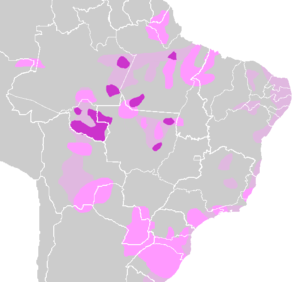Tupian languages
| Tupian | |
|---|---|
| Ethnicity | Tupí |
| Geographic distribution | Brazil, Bolivia, Paraguay, Uruguay, and North-East Argentina |
| Linguistic classification | Je-Tupi-Carib?
|
| Proto-language | Proto-Tupian |
| Subdivisions | |
| ISO 639-2 / 5 | tup |
| Glottolog | tupi1275[1] |
 Tupi–Guarani (medium pink), other Tupian (violet), and probable range ca. 1500 (pink-grey) | |
The Tupi or Tupian language family comprises some 70 languages spoken in South America, of which the best known are Tupi proper and Guarani.
Contents
Homeland and urheimat[edit]
Rodrigues (2007) considers the Proto-Tupian urheimat to be somewhere between the Guaporé and Aripuanã rivers, in the Madeira River basin.[2] Much of this area corresponds to the modern-day state of Rondônia, Brazil. 5 of the 10 Tupian branches are found in this area, as well as some Tupi–Guarani languages (especially Kawahíb), making it the probable urheimat of these languages and maybe of its speaking peoples. Rodrigues believes the Proto-Tupian language dates back to around 3,000 BC.
History, members and classification[edit]
When the Portuguese arrived in Brazil, they found that wherever they went along the vast coast of this newly discovered land, most natives spoke similar languages. Jesuit missionaries took advantage of these similarities, systematizing common standards then named línguas gerais ("general languages"), which were spoken in that region until the 19th century. The best known and most widely spoken of these languages was Old Tupi, a modern descendent of which is still used today by indigenous peoples around the Rio Negro region, where it is known as Nheengatu ([ɲɛʔẽŋaˈtu]), or the "good language". However, the Tupi family also comprises other languages.
In the neighbouring Spanish colonies, Guarani, another Tupian language closely related to Old Tupi, had a similar history, but managed to resist the spread of Spanish more successfully than Tupi resisted Portuguese. Today, Guarani has 7 million speakers, and is one of the official languages of Paraguay. The Tupian family also includes several other languages with fewer speakers. These share irregular morphology with the Je and Carib families, and Ribeiro connects them all as a Je–Tupi–Carib family.[3]
Rodrigues & Cabral (2012) list 10 branches of Tupian, which cluster into Western Tupian and Eastern Tupian.[2] Within Western and Eastern Tupian, the most divergent branches are listed first, followed by the core branches.
- Western Tupian
- Eastern Tupian
See also[edit]
- Apapocuva
- Indigenous languages of the Americas
- Languages of Brazil
- Língua Geral
- List of Spanish words of Indigenous American Indian origin
References[edit]
- ^ Hammarström, Harald; Forkel, Robert; Haspelmath, Martin, eds. (2017). "Tupian". Glottolog 3.0. Jena, Germany: Max Planck Institute for the Science of Human History.
- ^ a b Rodrigues, Aryon Dall'Igna, and Ana Suelly Arruda Câmara Cabral (2012). "Tupían". In Campbell, Lyle, and Verónica Grondona (eds). The indigenous languages of South America: a comprehensive guide. Berlin: De Gruyter Mouton.
- ^ Rodrigues A. D., 2000, "‘Ge–Pano–Carib’ X ‘Jê–Tupí–Karib’: sobre relaciones lingüísticas prehistóricas en Sudamérica", in L. Miranda (ed.), Actas del I Congreso de Lenguas Indígenas de Sudamérica, Tome I, Lima, Universidad Ricardo Palma, Facultad de lenguas modernas, p. 95-104.
Further reading[edit]
- Rodrigues, Aryon Dall'Igna (2007). "As consoantes do Proto-Tupí". In Ana Suelly Arruda Câmara Cabral, Aryon Dall'Igna Rodrigues (eds). Linguas e culturas Tupi, p. 167-203. Campinas: Curt Nimuendaju; Brasília: LALI.
External links[edit]
- Swadesh lists of Tupi–Guarani basic vocabulary words (from Wiktionary's Swadesh-list appendix)